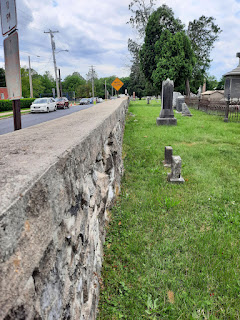 |
| Bob Broumley (my dad) at Kumwha, Korea. |
 |
| Shoulder Sleeve Insignia of the 187 RCT. |
 |
| Paratroopers of the 187th Airborne RCT on a training jump in Korea, circa 1953. |
The 11th Airborne
Division, along with the 187th Airborne Infantry Regiment, was
returned to the United States in 1949. The 11th Airborne Division
was stationed at Camp Campbell, Kentucky. Along with the 82nd
Airborne Division, the 11th was part of the strategic reserve of the
American Armed Forces. In February and March of 1950, the Rakkasans took part
in Operation Swarmer, the largest peacetime airborne maneuvers ever to be
conducted. Their performance in these maneuvers was instrumental in being
redesignated an Airborne Regimental Combat Team on August 27, 1950. The 187
Airborne RCT returned to Japan to serve as General MacArthur’s airborne forces
during the Korean War. While attached to the 1st Marine Division,
the 187 RCT followed up on the success of the Inchon Landing, clearing the
Kimpo Peninsula between the Han River and the Yellow Sea.
 |
| Training jump during the Korean War Era |
During their time in the
Korean War, the Rakkasans were awarded a Presidential Unit Citation and two
Korean Presidential Citations, as well as earning five more Battle Streamers
for their flag. Three soldiers from the 187 were awarded the Medal of Honor:
Lester Hammond, Jr., Rodolfo Hernandez, and Richard Wilson. Their success in
Korea re-energized the belief in using paratroopers as a strategic response.
Soon after, the XVIII Airborne Corps at Fort Bragg, North Carolina was
reactivated.
During the early 1960s, the
Rakkasans were part of a series of transfers and redesignations to help
experiment with new division formations for the Cold War. This included being
part of the 11th Air Assault Division (Test). By 1964, the 3/187th
Airborne was the only battalion of the regiment on active duty. They were
assigned to the 3rd Brigade of the newly reactivated 101st
Airborne Division. The 3rd Brigade, which included the 1st
and 2nd Battalions of the 506th Airborne, deployed to
Vietnam in December 1967. The Rakkasans spent the next four years in Vietnam,
fighting in twelve major engagements. They earned two Valorous Unit Awards and
two Presidential Unit Citations for the battles at Trang Bang and Dong Ap Bia
Mountain. The latter is better known as “Hamburger Hill.” Another Rakkasan,
Captain Paul W. Bucha, was awarded the Medal of Honor for his actions near
Phuoc Vinh in March of 1968. The 101st Airborne, along with the
3/187, returned to Fort Campbell in 1972.
By the Persian Gulf War in
1990, the 101st Airborne, along with the Rakkasans of the 3rd
Brigade had converted from airborne to air assault troops. During that 100 days
of ground combat, the 1/187 Infantry conducted an air assault 155 miles behind
enemy lines to Objective Weber capturing over 400 Iraqi soldiers on February
25, 1991. The operation into the Euphrates River valley cut off the retreating
enemy out of Kuwait. The Rakkasans had advanced further than any other Allied
unit, proving the viability of the air assault on the modern battlefield, and
did so without a single soldier killed in action.
As part of the Global War on
Terror (GWT), the Rakkasans deployed to Afghanistan in support of Operation
Enduring Freedom (OEF) in December 2001. As such, the 3rd Brigade,
101st Airborne became the first Army brigade to deploy in the
ongoing war on terror. The Rakkasans fought against the Taliban in eastern
Afghanistan, which included Operation Anaconda in March 2002.
Seven months after their
return from Afghanistan, the 3rd Brigade deployed to Kuwait for
Operation Iraqi Freedom (OIF1). On March 20, 2003, the Rakkasans led the 101st
Airborne Division into Iraq, establishing Forward Area Refueling Points (FARPs)
to support deep attacks into Iraq. They seized the city of Hillah and
participated in the liberation of Saddam Hussein International Airport before
going on to occupy portions of Baghdad. The BDE then moved to western Ninewah
province along the Syrian border for the remainder of the deployment,
establishing fledgling governance and reconstruction projects for the
betterment of the local population, while continuing operations against
insurgents.
The 3rd Brigade,
101st Airborne Division returned to Fort Campbell in early 2004 and
was reorganized under Army Transformation as the 3rd Brigade Combat
Team (BCT). The 3BCT then began a train up for returning to Iraq. They deployed
in September 2005 for OIF rotation 05-07. During this year-long deployment, the
Rakkasans fought the growing Sunni insurgency in Salah Ad Din Province, which
included Saddam Hussein’s hometown of Tikrit.
The Rakkasans deployed again
to Iraq for OIF 07-09 as part of the Iraq Surge in September 2007. This
rotation took the 3BCT to southwest and southern Baghdad between the Tigris and
Euphrates Rivers. This time the brigade was deployed for 15 months and
conducted operations against both Sunni and Shia insurgents.
The Rakkasans returned home
in November 2008. After their fourth refit and re-training period since 9/11,
the 3d Brigade Combat Team deployed again in January 2010. This time
they went to Afghanistan in support of OEF 10-11 as part of Regional
Command-East near the Afghan-Pakistan border. The Rakkasans were home in early
2011 but redeployed to Afghanistan again in September 2012. They came home to
Fort Campbell in May 2013 and are again preparing for their next deployment.
The banner under the
distinctive unit insignia of the 187th Infantry Regiment (Airborne)
bears the Latin words Ne Desit Virtus,
meaning “Let Valor Not Fail.” The soldiers of the 187 Infantry from every era
have certainly upheld their motto.






























